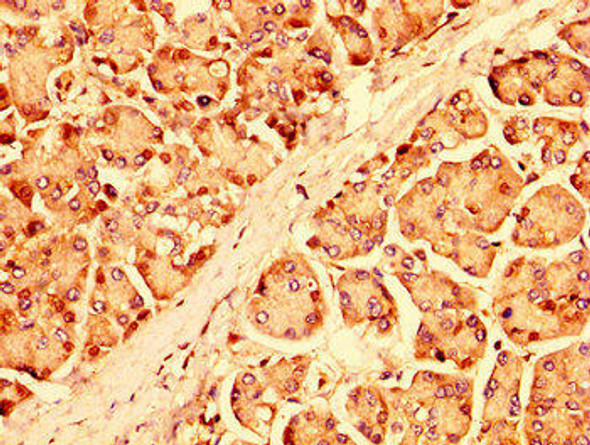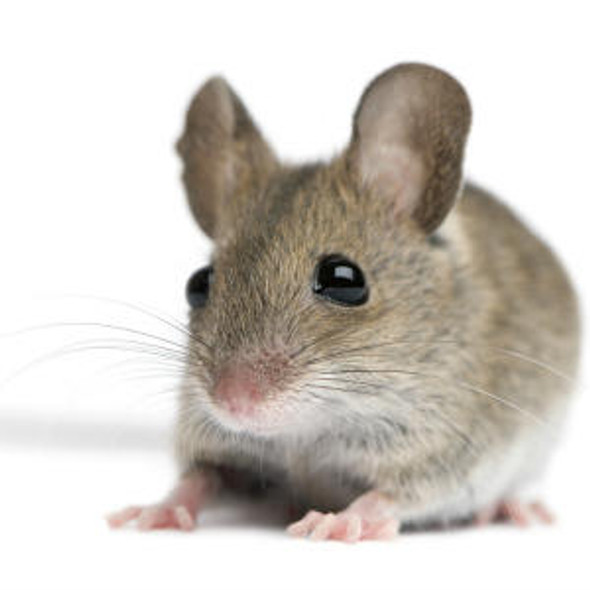Description
| Antibody Name: | UBR1 Antibody |
| Antibody SKU: | PACO01674 |
| Size: | 50ug |
| Host Species: | Rabbit |
| Tested Applications: | ELISA, WB, IHC |
| Recommended Dilutions: | WB:1:500-1:2000, IHC:1:100-1:300 |
| Species Reactivity: | Human, Mouse |
| Immunogen: | synthesized peptide derived from the Internal region of human Ubr1. |
| Form: | Liquid |
| Storage Buffer: | Liquid in PBS containing 50% glycerol, 0.5% BSA and 0.02% sodium azide. |
| Purification Method: | The antibody was affinity-purified from rabbit antiserum by affinity-chromatography using epitope-specific immunogen. |
| Clonality: | Polyclonal |
| Isotype: | IgG |
| Conjugate: | Non-conjugated |
| Synonyms: | UBR1; E3 ubiquitin-protein ligase UBR1; N-recognin-1; Ubiquitin-protein ligase E3-alpha-1; Ubiquitin-protein ligase E3-alpha-I |
| UniProt Protein Function: | UBR1: E3 ubiquitin-protein ligase which is a component of the N-end rule pathway. Recognizes and binds to proteins bearing specific N-terminal residues that are destabilizing according to the N-end rule, leading to their ubiquitination and subsequent degradation. May be involved in pancreatic homeostasis. Binds leucine and is a negative regulator of the leucine-mTOR signaling pathway, thereby controlling cell growth. Defects in UBR1 are a cause of Johanson-Blizzard syndrome (JBS). This disorder includes congenital exocrine pancreatic insufficiency, multiple malformations such as nasal wing aplasia, and frequent mental retardation. Pancreas of individuals with JBS do not express UBR1 and show intrauterine- onset destructive pancreatitis. Belongs to the UBR1 family. 2 isoforms of the human protein are produced by alternative splicing. |
| UniProt Protein Details: | Protein type:Ubiquitin ligase; Ligase; EC 6.3.2.19; EC 6.3.2.-; Ubiquitin conjugating system Chromosomal Location of Human Ortholog: 15q13 Cellular Component: cytoplasm; cytosol; proteasome complex; ubiquitin ligase complex Molecular Function:ligase activity; zinc ion binding Biological Process: negative regulation of TOR signaling pathway; protein ubiquitination Disease: Johanson-blizzard Syndrome |
| NCBI Summary: | The N-end rule pathway is one proteolytic pathway of the ubiquitin system. The recognition component of this pathway, encoded by this gene, binds to a destabilizing N-terminal residue of a substrate protein and participates in the formation of a substrate-linked multiubiquitin chain. This leads to the eventual degradation of the substrate protein. The protein described in this record has a RING-type zinc finger and a UBR-type zinc finger. Mutations in this gene have been associated with Johanson-Blizzard syndrome. [provided by RefSeq, Jul 2008] |
| UniProt Code: | Q8IWV7 |
| NCBI GenInfo Identifier: | 73622071 |
| NCBI Gene ID: | 197131 |
| NCBI Accession: | Q8IWV7.1 |
| UniProt Secondary Accession: | Q8IWV7,O60708, O75492, Q14D45, Q68DN9, Q8IWY6, Q96JY4 |
| UniProt Related Accession: | Q8IWV7 |
| Molecular Weight: | 93,184 Da |
| NCBI Full Name: | E3 ubiquitin-protein ligase UBR1 |
| NCBI Synonym Full Names: | ubiquitin protein ligase E3 component n-recognin 1 |
| NCBI Official Symbol: | UBR1 |
| NCBI Official Synonym Symbols: | JBS |
| NCBI Protein Information: | E3 ubiquitin-protein ligase UBR1 |
| UniProt Protein Name: | E3 ubiquitin-protein ligase UBR1 |
| UniProt Synonym Protein Names: | N-recognin-1; Ubiquitin-protein ligase E3-alpha-1; Ubiquitin-protein ligase E3-alpha-I |
| Protein Family: | E3 ubiquitin-protein ligase |
| UniProt Gene Name: | UBR1 |
| UniProt Entry Name: | UBR1_HUMAN |






